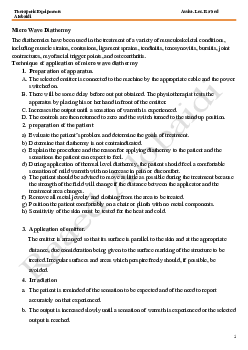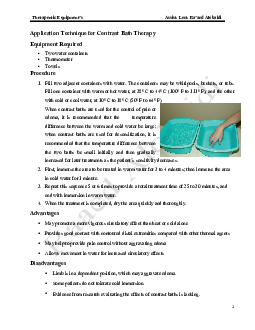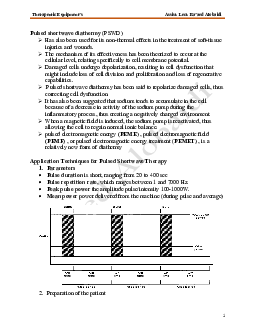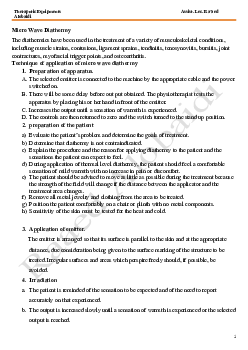



Preview text:
lOMoARcPSD|36041561
Therapeutic Equipment’s Assist. Lect. Ra’aed Alobaidi
Application Technique of Ultrasound Therapy
Ultrasound Treatment Parameters Frequency
The frequency is selected according to the depth of tissue to be treated.
For tissue up to 5 cm deep, 1 MHz is used, and 3 MHz is used for tissue 1 to 2 cm deep.
The depth of penetration is lower in tissues with high collagen content and in areas of increased reflection. Duty Cycle
The duty cycle is selected according to the treatment goal.
When the goal is to increase tissue
temperature, a 100% (continuous) duty cycle should be used.
When ultrasound is applied where only
the non-thermal effects without tissue
heating are desired, pulsed ultrasound
with a 20% or lower duty cycle should be used. Intensity
o Intensity is selected according to the treatment goal.
o When the goal is to increase tissue temperature, the patient should feel some
warmth within 2 to 3 minutes of initiating ultrasound application.
o When 1 MHz frequency ultrasound is used, an intensity of 1.5 to 2.0 W/cm2
will generally produce this effect.
o When 3 MHz frequency is used, an intensity of about 0.5 W/cm2 is generally sufficient. o Raaed Alobidi
For non-thermal effects, successful treatment outcomes have been
documented for most applications using an intensity of (0.5 to 1.0 W/cm2),
with as low as 0.15 W/cm2 sufficient for facilitation of bone healing. 1
Downloaded by Nga T??ng (ngahuong55@gmail.com) lOMoARcPSD|36041561
Therapeutic Equipment’s Assist. Lect. Ra’aed Alobaidi Duration of Treatment
The length of the treatment is dependent on several factors:
1. The size of the area to be treated; 2. The intensity in W/cm2; 3. The frequency;
4. The desired temperature increase.
Typically recommended treatment times have ranged between 5 and 10 minutes in length.
When the goal of treatment is to increase tissue temperature, the treatment duration
should be adjusted according to the frequency and intensity of the ultrasound.
Ultrasound rate of heating per minutes Exposure Techniques Direct Contact
Involves actual contact between the applicator and the
skin, a layer of gel should be applied to the treatment area
in sufficient amounts to maintain good contact and
lubrication between the transducer and the skin. Immersion (water bath)
The immersion technique is recommended if the area to
be treated is smaller than the diameter of the available
transducer or if the treatment area is irregular with bony Raaed Alobidi
prominences. A plastic, ceramic, or rubber basin should be
used, A basin filled with de-gassed water is used if
possible .Ordinary tap water presents the problem that gas
bubbles dissociate out from the water, accumulate on the
patients skin and the treatment head, and reflect the
ultrasonic beam. If tap water has to be used then the gas
bubbles must be wiped from these surfaces frequently
.The technique of application is that the treatment head is
held 0.5 - 1 cm from the skin and moved in small concentric circles. 2
Downloaded by Nga T??ng (ngahuong55@gmail.com) lOMoARcPSD|36041561
Therapeutic Equipment’s Assist. Lect. Ra’aed Alobaidi Bladder Technique
A bladder technique can be used in which a balloon,
surgical glove can be filled with water, and the
ultrasound energy is transmitted from the transducer
to the treatment surface through this bladder.
Both sides of the balloon should be coated with gel
to assure better contact. Treatments using a bladder
filled with either gel or silicone or degassed water
have also been used at higher ultrasound intensities. Commercial gel packs
Have gained popularity and several studies have
demonstrated their efficacy as a coupling medium.
When ultrasound is applied over bony prominences,
a gel pad should be covered with ultrasound gel on
both sides to ensure optimal heating.
Techniques of application Equipment Required • Ultrasound unit
• Gel, water, or other transmission medium • Antimicrobial agent • Towel
Evaluate the patient’s clinical findings and set the goals of treatment.
Confirm that ultrasound is not contraindicated for the patient or the condition.
Preparation of the patient and apparatus before use:-
1. Put the patient in comfortable position;
2. Remove the clothes from the area to be treated; 3. Raaed Alobidi
Select the optimal treatment parameters, including Ultrasound frequency, intensity, duty cycle, and duration;
the appropriate size of the treatment area; and the appropriate number and frequency of treatments. 3
Downloaded by Nga T??ng (ngahuong55@gmail.com) lOMoARcPSD|36041561
Therapeutic Equipment’s Assist. Lect. Ra’aed Alobaidi
Inspect the skin of the treated area:- 1. skin must be clean and dry;
2. sensitivity of the skin must be tested if there is hypersensitivity, by using very small dose;
3. Before treatment of any area with a risk of cross-infection, swab the sound
head with 0.5% alcoholic chlorhexidine, or use the antimicrobial approved for this use in the facility.
Explain the work of the apparatus to the patient:-
1) Tell the patient about the period of treatment.
2) Not necessary the patients feel any think during treatment.
3) If the patient feels pain in the treated area he must tell the physiotherapist.
If the patient complain of pain during the session you must:- 1) Increase the amount of gel; 2) Decreases the dosage;
3) Stop the session if the pain continues.
Apply an ultrasound transmission medium to the area to be treated.
1) Apply enough medium to eliminate any air between the sound head and the treatment area.
2) Select a medium that transmits ultrasound well, does not stain, is not
allergenic, is not rapidly absorbed by the skin, and is inexpensive.
Gels or lotions meeting these criteria have been specifically
formulated for use with ultrasound.
3) Or, for the application of ultrasound under water, place the area to be
treated in a container of water
Place the sound head on the treatment area and turn on the ultrasound Raaed Alobidi machine.
Move the sound head within the treatment area.
The sound head is moved at approximately 4 cm/second quickly enough to
maintain motion and slowly enough to maintain contact with the skin.
When the intervention is completed, remove the conduction medium from
the sound head and the patient, and reassess for any changes in status. 4
Downloaded by Nga T??ng (ngahuong55@gmail.com)



